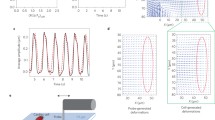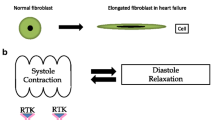Abstract
Cardiomyocytes are mechanosensitive. In the functioning heart, discrete sets of cardiac oscillators maintain stable relative phase dynamics and mechanical coupling between each other through the elastic tissue. A few questions that remains elusive to date are, how strong is the coupling and how tunable is their dynamics, whether this coupling is phase dependent, and if so, at what phase of cardiac dynamics is the coupling most dominant. In other words, at which phase of its dynamics a cardiac cell is most sensitive to forces and deformations induced by its neighbors. Here we address these questions by culturing rat cardiomyocytes on a stretchable substrate. We apply cyclic stretch on the substrate with a range of frequencies in the vicinity of the intrinsic beating frequency of the cell cluster. We find that the cell cluster can synchronize its dynamics with that of the substrate within 25% of its intrinsic frequency in less than a minute. However, it takes much longer time to return to its intrinsic frequency after removal of substrate stretch. With increasing substrate frequency, the cluster tends to catch up, and beats with a range of frequencies between the intrinsic and the applied with wide variation in relative phases. This allows us to measure phase dependent mechano-sensitivity of the cardiac cluster to the periodic deformation of the substrate that is critical to produce stable relative phase dynamics. We find that cardiac cells are most mechano sensitive when they are at 1/2 of their phase. This phase dependence might be mediated by the ion channels active at this phase of the dynamics. This study identifies a functional output of sub-second scale mechanotransduction with the potential to enhance or reinforce cardiac contractile dynamics.





Similar content being viewed by others
References
Bers DM (2002) Cardiac excitation–contraction coupling. Nature 415:198–205
Sherwood L (2015) Human physiology: from cells to systems. Cengage Learning, Boston
Ludwig A et al (1999) Two pacemaker channels from human heart with profoundly different activation kinetics. EMBO J 18:2323–2329
Hu H, Sachs F (1997) Stretch-activated ion channels in the heart. J Mol Cell Cardiol 29:1511–1523
Sachs F (2010) Stretch-activated ion channels: what are they? Physiology 25:50–56
Craelius W, Chen V, El-Sherif N (1988) Stretch activated ion channels in ventricular myocytes. Biosci Rep 8:407–414
Tatsukawa Y, Kiyosue T, Arita M (1997) Mechanical stretch increases intracellular calcium concentration in cultured ventricular cells from neonatal rats. Heart Vessel 12:128–135
Ruwhof C et al (2001) Mechanical stress stimulates phospholipase c activity and intracellular calcium ion levels in neonatal rat cardiomyocytes. Cell calcium 29:73–83
Tang X, Bajaj P, Bashir R, Saif TA (2011) How far cardiac cells can see each other mechanically. Soft Matter 7:6151–6158
Nitsan I, Drori S, Lewis YE, Cohen S, Tzlil S (2016) Mechanical communication in cardiac cell synchronized beating. Nature Phys 12:472–477
D’hooge J et al (2000) Regional strain and strain rate measurements by cardiac ultrasound: principles, implementation and limitations. Eur Heart J Cardiovasc Imaging 1:154–170
Ahmed W, Kural MH, Saif T (2010) A novel platform for in situ investigation of cells and tissues under mechanical strain. Acta Biomater 6(8):2979–90
Williams BJ, Anand SV, Rajagopalan J, Saif MTA (2014) A self-propelled biohybrid swimmer at low reynolds number. Nat Commun 5:3081
Schwachtgen J-L, Houston P, Campbell C, Sukhatme V, Braddock M (1998) Fluid shear stress activation of egr-1 transcription in cultured human endothelial and epithelial cells is mediated via the extracellular signal-related kinase 1/2 mitogen-activated protein kinase pathway. J Clin Investig 101:2540
Goldstein RE, Polin M, Tuval I (2009) Noise and synchronization in pairs of beating eukaryotic flagella. Phys Rev Lett 168103:103
Tops LF, Delgado V, Marsan NA, Bax JJ (2016) Myocardial strain to detect subtle left ventricular systolic dysfunction. Eur J Heart Fail 19(3):19
Acknowledgements
This project was funded by the National Science Foundation (NSF), Science and Technology Center on Emergent Behaviors in Integrated Cellular Systems (EBICS) Grant CBET-0939511
Author information
Authors and Affiliations
Contributions
B.J.W., and M.T.A.S. conceived the design, analyzed the data, and contributed to the manuscript. B.J.W. performed the experiments. M.T.A.S. directed the research.
Corresponding author
Additional information
Author Information
The authors declare no competing financial interests. Correspondence and requests for materials should be addressed to M.T.A.S. (saif@illinois.edu).
Publisher’s Note
Springer Nature remains neutral with regard to jurisdictional claims in published maps and institutional affiliations.
Rights and permissions
About this article
Cite this article
Williams, B., Saif, M. Phase Dependent Mechanosensitivity in Cardiomyocytes. Exp Mech 59, 387–393 (2019). https://doi.org/10.1007/s11340-019-00472-9
Received:
Accepted:
Published:
Issue Date:
DOI: https://doi.org/10.1007/s11340-019-00472-9




